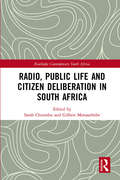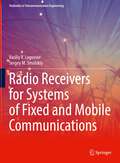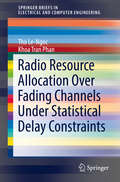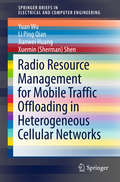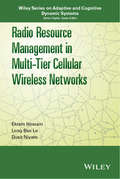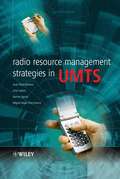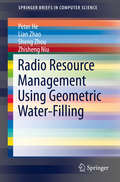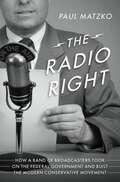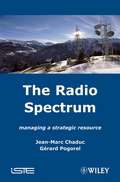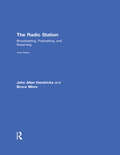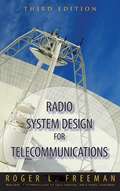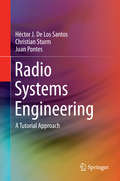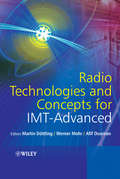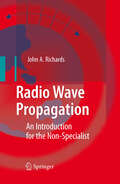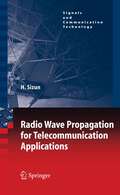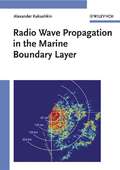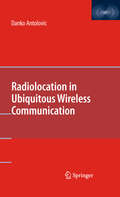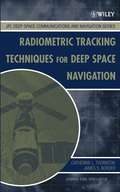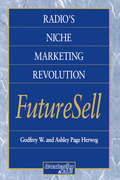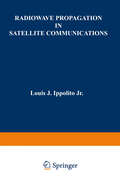- Table View
- List View
Radio, Public Life and Citizen Deliberation in South Africa (Routledge Contemporary South Africa)
by Sarah ChiumbuThis book critically analyses the important role of radio in public life in post-apartheid South Africa. As the most widespread and popular form of communication in the country, radio occupies an essential space in the deliberation and the construction of public opinion in South Africa. From just a few state-controlled stations during the apartheid era, there are now more than 100 radio stations, reaching vast swathes of the population and providing an important space for citizens to air their views and take part in significant socio-economic and political issues of the country. The various contributors to this book demonstrate that whilst print and television media often serve elite interests and audiences, the low cost and flexibility of radio has helped it to create a ‘common’ space for national dialogue and deliberation. The book also investigates the ways in which digital technologies have enhanced the consumption of radio and produced a sense of imagined community for citizens, including those in marginalised communities and rural areas. This book will be of interest to researchers with an interest in media, politics and culture in South Africa specifically, as well as those with an interest in broadcast media more generally.
Radio, Public Life and Citizen Deliberation in South Africa (Routledge Contemporary South Africa)
by Sarah Chiumbu Gilbert MotsaathebeThis book critically analyses the important role of radio in public life in post-apartheid South Africa. As the most widespread and popular form of communication in the country, radio occupies an essential space in the deliberation and the construction of public opinion in South Africa. From just a few state-controlled stations during the apartheid era, there are now more than 100 radio stations, reaching vast swathes of the population and providing an important space for citizens to air their views and take part in significant socio-economic and political issues of the country. The various contributors to this book demonstrate that whilst print and television media often serve elite interests and audiences, the low cost and flexibility of radio has helped it to create a ‘common’ space for national dialogue and deliberation. The book also investigates the ways in which digital technologies have enhanced the consumption of radio and produced a sense of imagined community for citizens, including those in marginalised communities and rural areas. This book will be of interest to researchers with an interest in media, politics and culture in South Africa specifically, as well as those with an interest in broadcast media more generally.
Radio Receivers for Systems of Fixed and Mobile Communications (Textbooks in Telecommunication Engineering)
by Sergey M. Smolskiy Vasiliy V. LogvinovThe textbook acquaints the reader with the architecture of receivers of analog and digital radio systems, helps to study the stages of designing a modern radio receiver and reveals the reasons and methods for its effective operation in networks for various purposes. Particular attention is paid to the methods of generating and processing signals in the receivers of digital systems with multiple access, which make it possible to provide data transfer rates close to the maximum possible (according to Shannon). As a textbook for students studying methods of optimal signal reception, the book will also be useful to specialists in the field of telecommunications involved in the development of radio receivers. The book shows how the development of theoretical, circuitry and integrated technologies led to the active introduction of algorithmic methods for signal processing changed both the design of receivers and the methods of forming the information flow in free space (MIMO, beamforming). The creation of a global 5G network based on heterogeneous networks puts forward new requirements for the architecture of receivers, which are determined by the requirements to achieve high data rates, low time delays or use in networks with coordinated multipoint transmission and reception (CoMP). To consolidate the knowledge gained, the book includes a complete set of materials for online classes, including questions and answers, a guide to solving problems for each chapter, and computer modeling units of receivers in the MicroCAP environment, based on preliminary calculations.
Radio Resource Allocation Over Fading Channels Under Statistical Delay Constraints (SpringerBriefs in Electrical and Computer Engineering)
by Tho Le-Ngoc Khoa Tran PhanThis SpringerBrief presents radio resource allocation schemes for buffer-aided communications systems over fading channels under statistical delay constraints in terms of upper-bounded average delay or delay-outage probability. This Brief starts by considering a source-destination communications link with data arriving at the source transmission buffer. The first scenario, the joint optimal data admission control and power allocation problem for throughput maximization is considered, where the source is assumed to have a maximum power and an average delay constraints. The second scenario, optimal power allocation problems for energy harvesting (EH) communications systems under average delay or delay-outage constraints are explored, where the EH source harvests random amounts of energy from renewable energy sources, and stores the harvested energy in a battery during data transmission. Online resource allocation algorithms are developed when the statistical knowledge of the random channel fading, data arrivals, EH processes governing the system dynamics is unknown a-priori. This Brief continues with a source-relay-destination communications link with buffers available at both source and relay, as part of a multi-hop network. Optimal resource allocation schemes for this 3-node relaying system to maximize its effective capacity under a delay-outage constraint are proposed, with special emphasis on relay roles: Half-duplex (HD) or full-duplex (FD) relay operation. With HD relay, the adaptive link selection relaying problem jointly with both fixed and adaptive power allocation schemes is investigated. Within each transmission frame, either the source-relay link or the relay-destination link is selected to be active depending on the channel conditions. With FD relay under the presence of non-zero residual self-interference (SI). This Brief also presents source and relay power allocation schemes for both cases of available knowledge of the channel state information at transmitter (CSIT): instantaneous or statistical. Professional and researchers working in this related field and advanced-level students in electrical or computer engineering will find the content valuable as a reference.
Radio Resource Management for Mobile Traffic Offloading in Heterogeneous Cellular Networks (SpringerBriefs in Electrical and Computer Engineering)
by Yuan Wu Li Ping Qian Jianwei Huang Xuemin Sherman ShenThis SpringerBrief offers two concrete design examples for traffic offloading. The first is an optimal resource allocation for small-cell based traffic offloading that aims at minimizing mobile users’ data cost. The second is an optimal resource allocation for device-to-device assisted traffic offloading that also minimizes the total energy consumption and cellular link usage (while providing an overview of the challenging issues). Both examples illustrate the importance of proper resource allocation to the success of traffic offloading, show the consequent performance advantages of executing optimal resource allocation, and present the methodologies to achieve the corresponding optimal offloading solution for traffic offloading in heterogeneous cellular networks. The authors also include an overview of heterogeneous cellular networks and explain different traffic offloading paradigms ranging from uplink traffic offloading through small cells to downlink traffic offloading via mobile device-to-device cooperation.This brief is an excellent resource for postgraduate students studying advanced-level topics in wireless communications and networking. Researchers, engineers and professionals working in related fields will also find this brief a valuable resource tool.
Radio Resource Management in Multi-Tier Cellular Wireless Networks (Adaptive and Cognitive Dynamic Systems: Signal Processing, Learning, Communications and Control)
by Ekram Hossain Long Bao Le Dusit NiyatoProviding an extensive overview of the radio resource management problem in femtocell networks, this invaluable book considers both code division multiple access femtocells and orthogonal frequency-division multiple access femtocells. In addition to incorporating current research on this topic, the book also covers technical challenges in femtocell deployment, provides readers with a variety of approaches to resource allocation and a comparison of their effectiveness, explains how to model various networks using Stochastic geometry and shot noise theory, and much more.
Radio Resource Management in Multi-Tier Cellular Wireless Networks (Adaptive and Cognitive Dynamic Systems: Signal Processing, Learning, Communications and Control)
by Ekram Hossain Long Bao Le Dusit NiyatoProviding an extensive overview of the radio resource management problem in femtocell networks, this invaluable book considers both code division multiple access femtocells and orthogonal frequency-division multiple access femtocells. In addition to incorporating current research on this topic, the book also covers technical challenges in femtocell deployment, provides readers with a variety of approaches to resource allocation and a comparison of their effectiveness, explains how to model various networks using Stochastic geometry and shot noise theory, and much more.
Radio Resource Management Strategies in UMTS
by Jordi Perez Romero Oriol Sallent Ramon Agusti Miguel Angel Diaz-GuerraThe key feature of future mobile communication systems is the ability to deliver wideband and high bit-rate multimedia services alongside the traditional radio services such as voice, messaging and slow rate data. The broad range of services expected to be supported can be divided into different Quality of Service (QoS) classes. However, the provision of such mobile multimedia services under QoS guarantees will not be possible without a utilization of the air interface resources by means of Radio Resource Management (RRM) strategies that ensure the target QoS, the planned coverage area and that offer a high system capacity. Under this framework, the book focuses on the RRM concepts, including the theoretical background that serves as a basis for the description of specific RRM algorithms. The RRM problem for UMTS is presented, and more specifically, for the FDD mode, which is based on a WCDMA scheme. More specifically, the different aspects that are covered include: Introduces the mobile communications sector and UMTS, including the evolution towards 4G systems, with an overview of the QoS concept which is key for the definition of RRM strategies Offers a detailed description of the radio interface in UMTS, as the basis for the implementation of RRM strategies Provides the fundamental concepts related with the development of RRM strategies in WCDMA networks Analyses particular RRM algorithms in a variety of scenarios, trying to identify the key parameters and factors that influence their performance Explores the evolution of UMTS towards Beyond 3G systems and the concept of Common RRM in heterogeneous networks with the aid of some algorithm examples This comprehensive title is essential reading for engineers and managers in radio engineering departments of UMTS network operators and UMTS equipment manufacturers. It will also prove insightful to researchers in the field of 3G and Beyond 3G systems and academics in any of these areas.
Radio Resource Management Using Geometric Water-Filling (SpringerBriefs in Computer Science)
by Peter He Lian Zhao Sheng Zhou Zhisheng NiuThis brief introduces the fundamental theory and development of managing radio resources using a water-filling algorithm that can optimize system performance in wireless communication. Geometric Water-Filling (GWF) is a crucial underlying tool in emerging communication systems such as multiple input multiple output systems, cognitive radio systems, and green communication systems. Early chapters introduce emerging wireless technologies and provide a detailed analysis of water-filling. The brief investigates single user and multi-user issues of radio resource management, allocation of resources, and energy harvesting. Effective algorithms demonstrate the incredible potential capabilities of water-filling mechanisms. This brief is designed for researchers and professionals working with resource management and wireless communications. Advanced-level students in computer science and engineering will also find the information valuable.
The Radio Right: How a Band of Broadcasters Took on the Federal Government and Built the Modern Conservative Movement
by Paul MatzkoIn the past few years, trust in traditional media has reached new lows. Many Americans disbelieve what they hear from the "mainstream media," and have turned to getting information from media echo chambers which are reflective of a single party or ideology. In this book, Paul Matzko reveals that this is not the first such moment in modern American history. The Radio Right tells the story of the 1960s far Right, who were frustrated by what they perceived to be liberal bias in the national media, particularly the media's sycophantic relationship with the John F. Kennedy administration. These people turned for news and commentary to a resurgent form of ultra-conservative mass media: radio. As networks shifted their resources to television, radio increasingly became the preserve of cash-strapped, independent station owners who were willing to air the hundreds of new right-wing programs that sprang up in the late 1950s and 1960s. By the early 1960s, millions of Americans listened each week to conservative broadcasters, the most prominent of which were clergy or lay broadcasters from across the religious spectrum, including Carl McIntire, Billy James Hargis, and Clarence Manion. Though divided by theology, these speakers were united by their distrust of political and theological liberalism and their antipathy towards JFK. The political influence of the new Radio Right quickly became apparent as the broadcasters attacked the Kennedy administration's policies and encouraged grassroots conservative activism on a massive scale. Matzko relates how, by 1963, Kennedy was so alarmed by the rise of the Radio Right that he ordered the Internal Revenue Service and Federal Communications Commission to target conservative broadcasters with tax audits and enhanced regulatory scrutiny via the Fairness Doctrine. Right-wing broadcasters lost hundreds of stations and millions of listeners. Not until the deregulation of the airwaves under the Carter and Reagan administrations would right-wing radio regain its former prominence. The Radio Right provides the essential pre-history for the last four decades of conservative activism, as well as the historical context for current issues of political bias and censorship in the media.
The Radio Right: How a Band of Broadcasters Took on the Federal Government and Built the Modern Conservative Movement
by Paul MatzkoIn the past few years, trust in traditional media has reached new lows. Many Americans disbelieve what they hear from the "mainstream media," and have turned to getting information from media echo chambers which are reflective of a single party or ideology. In this book, Paul Matzko reveals that this is not the first such moment in modern American history. The Radio Right tells the story of the 1960s far Right, who were frustrated by what they perceived to be liberal bias in the national media, particularly the media's sycophantic relationship with the John F. Kennedy administration. These people turned for news and commentary to a resurgent form of ultra-conservative mass media: radio. As networks shifted their resources to television, radio increasingly became the preserve of cash-strapped, independent station owners who were willing to air the hundreds of new right-wing programs that sprang up in the late 1950s and 1960s. By the early 1960s, millions of Americans listened each week to conservative broadcasters, the most prominent of which were clergy or lay broadcasters from across the religious spectrum, including Carl McIntire, Billy James Hargis, and Clarence Manion. Though divided by theology, these speakers were united by their distrust of political and theological liberalism and their antipathy towards JFK. The political influence of the new Radio Right quickly became apparent as the broadcasters attacked the Kennedy administration's policies and encouraged grassroots conservative activism on a massive scale. Matzko relates how, by 1963, Kennedy was so alarmed by the rise of the Radio Right that he ordered the Internal Revenue Service and Federal Communications Commission to target conservative broadcasters with tax audits and enhanced regulatory scrutiny via the Fairness Doctrine. Right-wing broadcasters lost hundreds of stations and millions of listeners. Not until the deregulation of the airwaves under the Carter and Reagan administrations would right-wing radio regain its former prominence. The Radio Right provides the essential pre-history for the last four decades of conservative activism, as well as the historical context for current issues of political bias and censorship in the media.
The Radio Spectrum: Managing a Strategic Resource
by Jean-Marc Chaduc G¿rard PogorelRadio frequencies have become a basic resource for the development of the information society. In fact, radio waves are a mandatory vehicle in order to carry the message to customers and a truly worldwide communication needs their properties. Given the market demands for more and more frequencies, means have to be found to share this limited resource most effectively and to continuously improve its efficiency. Radio spectrum management is thus a major objective for our modern world. This book describes the current tools for spectrum management with their fundamental technical and legal basis. It outlines the global evolution of radio services in their different application domains and introduces the actors who contribute to the collective management of the spectrum. It also discusses the main questions these actors have to deal with and answer in order to design for the future.
The Radio Station: Broadcasting, Podcasting, and Streaming
by John Allen Hendricks Bruce MimsThe Radio Station offers a concise and insightful guide to all aspects of radio broadcasting, streaming, and podcasting. This book’s tenth edition continues its long tradition of guiding readers to a solid understanding of who does what, when, and why in a professionally managed station. This new edition explains what "radio" in America has been, where it is today, and where it is going, covering the basics of how programming is produced, financed, delivered and promoted via terrestrial and satellite broadcasting, streaming and podcasting, John Allen Hendricks and Bruce Mims examine radio and its future within a framework of existing and emerging technologies. The companion website is new revised with content for instructors, including an instructors’ manual and test questions. Students will discover an expanded library of audio interviews with leading industry professionals in addition to practice quizzes and links to additional resources.
The Radio Station: Broadcasting, Podcasting, and Streaming
by John Allen Hendricks Bruce MimsThe Radio Station offers a concise and insightful guide to all aspects of radio broadcasting, streaming, and podcasting. This book’s tenth edition continues its long tradition of guiding readers to a solid understanding of who does what, when, and why in a professionally managed station. This new edition explains what "radio" in America has been, where it is today, and where it is going, covering the basics of how programming is produced, financed, delivered and promoted via terrestrial and satellite broadcasting, streaming and podcasting, John Allen Hendricks and Bruce Mims examine radio and its future within a framework of existing and emerging technologies. The companion website is new revised with content for instructors, including an instructors’ manual and test questions. Students will discover an expanded library of audio interviews with leading industry professionals in addition to practice quizzes and links to additional resources.
Radio System Design for Telecommunications (Wiley Series in Telecommunications and Signal Processing #98)
by Roger L. FreemanStep-by-step tutorial to master current design techniques for wireless communication systems The Third Edition of Radio System Design for Telecommunications brings this highly acclaimed book fully up to date with the latest technological advances and new applications. At the same time, the hallmarks of the previous editions, including the text's popular tutorial presentation, have been retained. Readers therefore get all the tools and guidance they need to master an essential set of current design techniques for radio systems that operate at frequencies of 3 MHz to 100 GHz. Using simple mathematics, the author illustrates design concepts and applications. The book's logical organization, beginning with a discussion of radio propagation problems, enables readers to progressively develop the skills and knowledge needed to advance in the text. Topics that are new to the Third Edition include: Chapter devoted to wireless LANs (WLANs) as detailed in IEEE 802.11 Subsections covering IEEE 802.15, 802.16, 802.20, and the wireless metropolitan area network (WMAN) WiFi, WiMax, and UWB applications that have recently experienced explosive growth Broadband radio in telecommunications, as well as offset frequency division multiplex (OFDM), a new technique for transmitting information in an interference environment The use of very small aperture satellite terminal (VSAT) systems as an economical alternative to public switched telecommunication networks (PSTN) Review questions and problems at the end of each chapter engage readers' newfound skills and knowledge and help them assess whether they are ready to progress to the next chapter. References are provided for readers who want to investigate particular topics in greater depth. Students in wireless telecommunications will find the book's tutorial style ideal for learning all the ins and outs of radio system design, whereas professionals in the industry will want to refer to the Third Edition for its clear explanations of the latest technology and applications.
Radio Systems Engineering: A Tutorial Approach
by Héctor J. De Los Santos Christian Sturm Juan PontesThis book is intended for readers who already have knowledge of devices and circuits for radio-frequency (RF) and microwave communication and are ready to study the systems engineering-level aspects of modern radio communications systems. The authors provide a general overview of radio systems with their components, focusing on the analog parts of the system and their non-idealities. Based on the physical functionality of the various building blocks of a modern radio system, block parameters are derived, which allows the examination of their influence on the overall system performance. The discussion is complemented by tutorial exercises based on the Agilent SystemVue electronic system-level (ESL) design software. With these tutorials, readers gain practical experience with realistic design examples of radio transmission systems for communications and radar sensing. The tutorials cover state-of-the-art system standards and applications and consider the characteristics of typical radio-frequency hardware components. For all tutorials, a comprehensive description of the tasks, including some hints to the solutions, is provided. The readers are then able to perform these tasks independently. A complete set of simulation models and solutions to the tutorial exercises is given.
Radio Technologies and Concepts for IMT-Advanced
by Martin Döttling Werner Mohr Afif OsseiranRadio Technologies and Concepts for IMT-Advanced presents the findings of the Wireless World Initiative New Radio (WINNER) project in Framework Program 6 of the European Commission. It provides an insight into the key concepts and technologies for the IMT-Advanced radio interface, based on the collaborative research of manufacturers, network operators, research centres and universities within WINNER. The book covers the fundamental radio characteristics of a typical 4G wireless communication system, focusing on the transceiver’s chain from the physical layer to layers 2 and 3. Starting by defining realistic and futuristic usage scenarios, the authors provide in-depth discussion of key technologies including modulation and coding, link level procedures, spatial-temporal processing, multiple access schemes and inter-cell interference mitigation, channel estimation and newly developed channel models. Finally, a cost assessment and optimisation methodology is developed for different deployment concepts in order to assess a wireless system in a condition close to reality. The book provides an important system-level approach to the latest radio technologies in the field, and evaluates IMT-Advanced research in relation to international standardisation. Presents the research findings of IMT-Advanced radio interface from the WINNER project Covers the latest concepts for relaying, multiple access, radio resource control, flexible spectrum use, and ITU-R spectrum demand calculation Examines the most recent Multiple-Input, Multiple-Output (MIMO) techniques, and Distributed Antenna Systems (Coordinated Multipoint Transmissions) Describes a 4G system concept and all major building blocks Provides 4G propagation models and system-level evaluation methodologies
Radio Wave Propagation: An Introduction for the Non-Specialist
by John A. RichardsThis work treats the essential elements of radio wave propagation without requiring recourse to advanced electromagnetic concepts and equations. However, it provides sufficient detail to allow those concerned with wireless systems to acquire quickly a practical working knowledge of the important concepts. Radio wave propagation is placed in a practical context by considering the design aspects of communications systems at microwave frequencies. A fuller consideration of the electromagnetic properties of materials is given late in the book rather than as an introductory chapter.
Radio Wave Propagation for Telecommunication Applications (Signals and Communication Technology)
by Hervé SizunRadio Wave Propagation in the Marine Boundary Layer
by Alexander KukushkinBased on his many years of professional experience at leading companies in communications technology, the author describes an analytical solution for wave propagation over the sea surface in an atmospheric boundary layer. His approach allows the detailed analysis of combined effects of diffraction, refraction and scattering in random media. While specific applications covered are targeted at radio wave propagation over the sea surface, a similar approach is applicable to many problems in underwater acoustics, seismology, solid matter physics and astrophysics.
Radiolocation in Ubiquitous Wireless Communication
by Danko AntolovicThisvolumehasitsbeginningsinalaboratoryproject,developmentofaradiolocator for the Wi-Fi network that was growing by leaps and bounds on the campus of Indiana University at that time. What started as a very focused and practical attempt to improve network management, touched in its lifetime upon broader issues of the use of radio spectrum, design of system architectures for the wireless medium, and image formation outside the limits of geometrical optics. Ihaveintendedthisbookmostlyfortheaudienceofengineersandsystemdesi- ers, in the growing ?eld of radio communication among small, portable, ubiquitous devices that have become hybrid platforms for personal communication and p- sonal computing. It is also a book addressed to network professionals, people to whom radio is largely a black box, a medium that they usually rely upon, but s- dom fully understand. In fact, in the course of my work in the ?eld, I have witnessed, to my dismay, a wide disconnect between the networking world and the radio technology that n- working has come to depend upon so heavily. Perhaps, because digital wireless communication is seen as digital ?rst and wireless second, there is often a m- placed emphasis on its information-processingside, with the methodologycentered around the discrete symbol, and with little intuition of the underlying physics. I had it once suggested to me, in apparent seriousness, to use radio cards for intra-system communication within a radiolocator! Wireless communication is radio, plain and simple.
Radiometric Tracking Techniques for Deep-Space Navigation
by Catherine L. Thornton James S. BorderRadiometric Tracking Techniques for Deep-Space Navigation focuses on a broad array of technologies and concepts developed over the last four decades to support radio navigation on interplanetary spacecraft. In addition to an overview of Earth-based radio navigation techniques, the book includes a simplified conceptual presentation of each radiometric measurement type, its information content, and the expected measeurement accuracy. The methods described for both aquiring and calibrating radiometric measurements also provide a robust system to support guidance and navigation for future robotic space exploration.
Radios Niche Marketing Revolution FutureSell
by Ashley Herweg Godfrey HerwegRadio's niche marketing revolution evolved to address the problems of market fragmentation. These problems are responsible for steep declines in traditional media revenues. Market fragmentation, happening in every market across the globe, has led marketers and media into the new era of niche marketing. Mass-marketing strategies are obsolete. Radio, cable (wired and unwired), and television are being forced to alter the way they present their products, promotions, and marketing strategies. FutureSell provides radio professionals with the advanced skills and systems to turn niche marketing into a profitable approach for their own stations.Your clients don't want to buy advertising¦period. They do, however, want to sell their products and services. Your advertisers' markets are also fragmenting. Cutting-edge companies now seek ways to learn their customers' smallest needs and cater to their customers' perceptions. Yet, very few businesses or ad agencies know how to conduct niche or one-to-one marketing. With the techniques introduced in this book, you can create new revenue streams while upgrading your largest advertisers.The ideas you'll encounter work for multi-national media conglomerates, stations in small markets, and duopolies in any market size. Owners, group heads, managers, salespeople, programmers, copywriters, and office staff will gain valuable insight to make their jobs easier and more productive. Radio people, ad agency executives, and advertisers will discover a money-making glimpse into the future.Godfrey W. and Ashley Page Herweg are radio management consultants, international seminar leaders, sales trainers, and researchers specializing in niche marketing and focus group studies. They have successful backgrounds in, radio, television, and print production, and media buying and sales at the international, national, regional, and local levels. The Herwegs have owned, operated, and managed radio stations in small, medium, and large markets. The Herwegs have also co-authored, Making More Money Selling Radio Advertising Without Numbers and Recruiting, Interviewing, Hiring, and Developing SUPERIOR SALESPEOPLE
Radios Niche Marketing Revolution FutureSell
by Ashley Herweg Godfrey HerwegRadio's niche marketing revolution evolved to address the problems of market fragmentation. These problems are responsible for steep declines in traditional media revenues. Market fragmentation, happening in every market across the globe, has led marketers and media into the new era of niche marketing. Mass-marketing strategies are obsolete. Radio, cable (wired and unwired), and television are being forced to alter the way they present their products, promotions, and marketing strategies. FutureSell provides radio professionals with the advanced skills and systems to turn niche marketing into a profitable approach for their own stations.Your clients don't want to buy advertising¦period. They do, however, want to sell their products and services. Your advertisers' markets are also fragmenting. Cutting-edge companies now seek ways to learn their customers' smallest needs and cater to their customers' perceptions. Yet, very few businesses or ad agencies know how to conduct niche or one-to-one marketing. With the techniques introduced in this book, you can create new revenue streams while upgrading your largest advertisers.The ideas you'll encounter work for multi-national media conglomerates, stations in small markets, and duopolies in any market size. Owners, group heads, managers, salespeople, programmers, copywriters, and office staff will gain valuable insight to make their jobs easier and more productive. Radio people, ad agency executives, and advertisers will discover a money-making glimpse into the future.Godfrey W. and Ashley Page Herweg are radio management consultants, international seminar leaders, sales trainers, and researchers specializing in niche marketing and focus group studies. They have successful backgrounds in, radio, television, and print production, and media buying and sales at the international, national, regional, and local levels. The Herwegs have owned, operated, and managed radio stations in small, medium, and large markets. The Herwegs have also co-authored, Making More Money Selling Radio Advertising Without Numbers and Recruiting, Interviewing, Hiring, and Developing SUPERIOR SALESPEOPLE
Radiowave Propagation in Satellite Communications
by Louis J. IppolitoRadiowave Propagation in Communications was written with two basic objec tives: (l) to present an up-to-date review of the major radiowave propagation phenomena which hinder reliable space communications, and (2) to describe how these propagation phenomena affect the design and performance of satellite communications systems. Earth-orbiting satellites are employed extensively for the relay of information in a vast array of telecommunications, meteorological, government, and sci entific applications. Satellite systems rely on the transmission of radiowaves to and from the satellite and are dependent on the propagation characteristics of the transmission path, primarily the earth's atmosphere. Radiowave propagation thus plays a very important part in the design and ultimate performance of space communications systems. This book presents, for the first time, the meshing in a single publication of the fundamentals of radiowave propagation factors with a discussion of the practical consequences of these factors on satellite communications systems. Two major subfie1ds are involved in this book. Radiowave propagation, which is basically applied electromagnetic theory, provides the theory and an alytical tools for the first several chapters. Later chapters then apply propagation effects to the field of electrical engineering involved with satellite communi cations. The material progresses from the essential aspects of radiowave prop agation to the application of practical methods and techniques in the design and performance of satellite communications systems.
